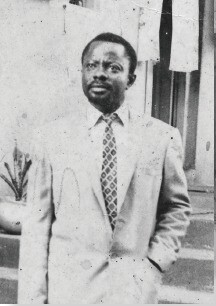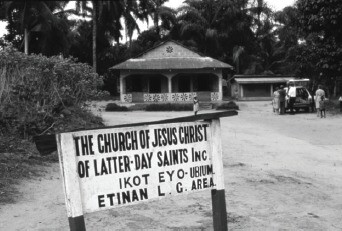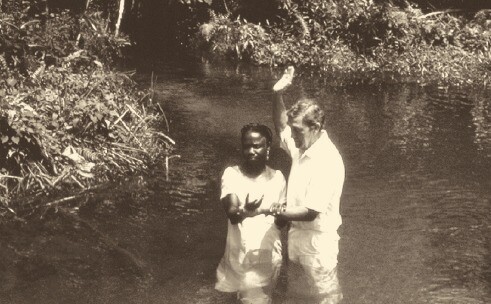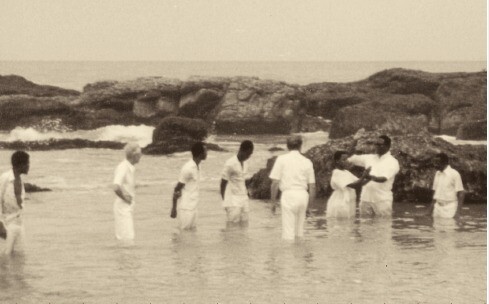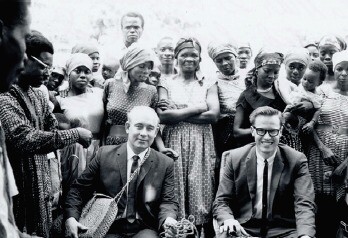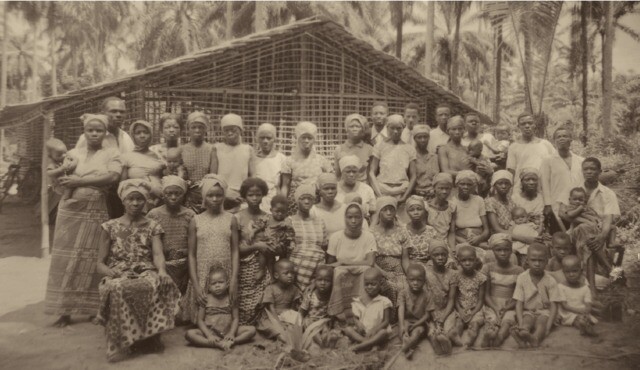Editor’s note: This article was originally published to commemorate the 30th anniversary of the revelation declaring that all worthy males, regardless of race, may receive the priesthood. We are sharing it again to mark the 40th anniversary and to celebrate the continuing growth of the Church in Africa.
In 1978, I was presiding over the only mission on the continent of Africa—the South Africa Johannesburg Mission. Although there were no black members of the Church in South Africa at that time due to rigid apartheid laws restricting blacks from attending public meetings with whites there were some who had already become converted to the gospel. Here is the unique and inspiring story of the gospel pioneers of Africa before and after the priesthood revelation.
► You'll also like: First Black Man Sealed in the Salt Lake Temple Shares the Moment He Heard the Priesthood Revelation
Tuning In
Joseph Johnson returned to his small, modest home in Cape Coast, Ghana, Africa, late at night on June 9, 1978. Weary and frustrated, Johnson felt that his hard work and loyalty to the church he loved appeared wasted. For 14 years, he had devoted himself to preaching the restored gospel of Jesus Christ. He had brought hundreds into the faith and had organized a dozen branches of the Church in his native land. He had built chapels and established Sunday Schools and Primaries—all without being baptized. Johnson wrote letters to Church authorities asking for assistance and for missionaries to come to baptize him and many others, but Salt Lake City’s hands were tied, and their answer to Johnson was to wait and be patient.
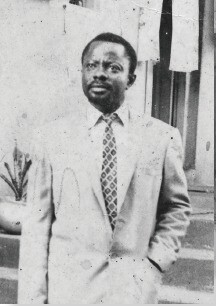
Joseph Johnson in Cape Coast, Ghana
So Johnson continued to preach among the people with great enthusiasm, hoping for assistance. It was a challenging and trying time. His wife left him; he lost his job; he was bitterly persecuted by police and other churches. After 14 long years, Johnson felt he was at the end of his strength and endurance.
On this evening, overcome with exhaustion and discouragement, Johnson collapsed into his chair. After several minutes, he felt impressed to turn on his short-wave radio and listen to the British Broadcasting Corporation (BBC), something he had not done for several years. After trying for more than an hour, he was finally able to tune in to the BBC station at the top of its midnight news broadcast. One of the first items Johnson heard was a special report that electrified him. He recalled, “I heard the message of President Kimball’s revelation . . . that all worthy male members could receive the priesthood. I burst into tears of joy because I knew the priesthood and the Church would now come to Africa, and, if we did the right things, we would receive the priesthood.”
Finding the Gospel
Many of the early African pioneers learned about the Church through pamphlets, missionary tracts, or other literature they obtained from friends and relatives who traveled to Europe or America. In 1947, Bassey Daniel Udoh of Nigeria learned about the Church when he received a pamphlet containing Joseph Smith’s testimony. He was deeply impressed with what he read, and he wrote to Church headquarters requesting more literature and someone to teach him the gospel. But the time was not yet. He waited patiently for more than 30 years. When missionaries arrived in Nigeria in 1978, Bassey Daniel Udoh was one of the first to be baptized.

Joseph Johnson, spoken of at the beginning of this article, was one of the most faithful and dedicated early pioneers in Africa. In 1964, he prayerfully read the Book of Mormon, which immediately changed his life. He felt so strongly about what he had read that he felt compelled to preach about it in towns and villages within a 70-mile radius of his home in Ghana. He organized several congregations and called them “The Church of Jesus Christ of Latter-day Saints.” He placed signs in front of the meeting places and printed stationery with the same name on the letterhead. It was estimated that when the missionaries finally arrived, there were more than 1,200 people prepared for baptism as a result of Johnson’s valiant missionary efforts and leadership.
As more and more people in Nigeria and Ghana learned about the gospel, letters began pouring in to Salt Lake City from Africa asking for more information. What began as a comparative trickle of requests in the early 1950s became a flood by the 1960s, and for several decades, more letters requesting literature and missionaries were sent to Church headquarters from Africa than from the rest of the world combined. One particular letter, with the Church’s name on its letterhead, was sent from “The Church of Jesus Christ of Latter-day Saints, Nigeria Branch.”
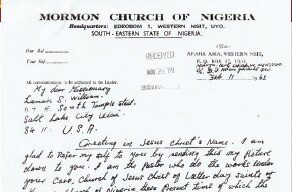
Unofficial “official” Church letterhead prepared by early Nigerian Saints in 1969 to correspond with Church leaders
Church headquarters responded by sending literature. The demand for more information was so great that some industrious Africans even established an LDS bookstore in Nigeria.
Fact-Finding Missions
The first official Church representative to visit central Africa was President Glen G. Fisher of the South Africa Mission. He was assigned by the First Presidency to visit Nigeria on his return home and investigate some of the groups located near Lagos. In July 1960, he met with a few leaders of the congregations that had taken the name of the Church. Four of these men had organized themselves into a presidency and were holding a "branch presidency" meeting as he arrived. President Fisher recorded:
“Never have I received a more sincere and enthusiastic welcome. . . . They were living in extreme poverty. In one church there were no seats, no musical instruments, and no pulpit. The preacher carried his supplies in a wooden box that he used as a pulpit.
“Supplies consisted of a few Bibles, some missionary pamphlets, The Articles of Faith, A Marvelous Work and a Wonder, and the Book of Mormon. I found similar literature in all the churches I visited. Using this literature, they tried to organize a church patterned after the Mormon Church. . . .I was impressed with their sincerity and knowledge. Their only source of information was the literature received from Church headquarters.
“For years they had been preparing their congregations for baptism [into the Church]. They had two congregations, with a total membership of over 1,000 people. With some pride, the president said that not one of them smoked or used alcoholic beverages.”

Bassey Daniel Udoh, Elder LaMar Williams
By 1964, it was estimated that there were more than 8,400 Africans in 135 congregations in Nigeria and about 200 members of several congregations in Ghana adhering to the teachings of the Church and bearing its name.
In 1961, President David O. McKay assigned Elder LaMar Williams, secretary to the Church Missionary Department, to go to Nigeria on a fact-finding mission to determine if the people were sincere and willing to accept membership in the Church even though they could not yet hold the priesthood. Although Elder Williams had been responding to the flood of letters from Africa, he was not prepared for what he found there. He was met at the airport in Nigeria by 10 pastors with whom he had been corresponding. He was surprised to discover that not only did each pastor operate independently but they were not even aware of each other.
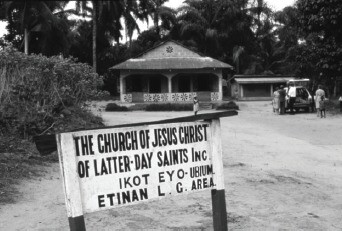
Sign in front of meetinghouse
The first official Church meeting in black Africa was held in October 1961 in a small mud hut in Nigeria, where Elder Williams met with a pastor and 110 followers. No one came by car. Many, including eight mothers with small children, had begun their day before 4 a.m. and walked 25 miles or more to be there. After teaching them for two hours, Elder Williams prepared to end the
meeting. He recorded:
“It was hot as blazes. . . . My suit was wringing wet. . . . When I turned the meeting back to [the pastor], I heard a murmur all through the congregation . . . and [the pastor] said to me, ‘They don’t want to go home. They have something to say.’ Then for three hours these people were standing up bearing testimonies to the truthfulness of the Church and how they believed in the prophets. I could not believe what I was hearing.
“One elderly gentleman stood and spoke emphatically: ‘I am an old man. I am sick. But when I heard you were going to be here, I walked 16 miles this morning to see you and to hear what you have to say. I still have to walk 16 miles to get back home, and I am not well. I want you to know that I am sincere or I would not be here. I have not seen President McKay. I have not seen God. But I have seen you, and I will hold you personally accountable to tell President McKay that I am sincere.’”
President Fisher reported to the First Presidency that he found the people of Nigeria to be very sincere and devout in their convictions about the Book of Mormon, the Prophet Joseph Smith, and the Restoration. He recommended that the Church send missionary couples to Africa to organize the Church and begin baptizing those who were ready.
Elder Williams made two additional trips to Nigeria. In 1966, President McKay called Elder and Sister Williams and two other couples to serve as the first missionaries in Nigeria. However, the Nigerian government refused to issue the needed visas, and very soon after Elder Williams’s third trip, the Biafra War—the most destructive civil war to that point in recorded African history—erupted in Nigeria. The most vicious fighting occurred in the same area where these faithful congregations were located, and the Church was compelled to abandon its efforts. It would be many long years before they were allowed to return.
Patiently Waiting
During this dark and troubling time, Anthony Obinna was one of the hundreds who waited for the Church to be officially established in his beloved Nigeria. He was a lifelong seeker of truth and one of the faithful and persistent early pioneers in Africa. In the late 1960s, Obinna had a dream about a beautiful building he had never seen before. Then, in 1970, he stumbled across the September 1958 issue of Reader’s Digest. He recalled: “There was an article titled ‘The March of the Mormons,’ with a picture of the Salt Lake Temple. It was exactly the same building I had seen in my dreams.”
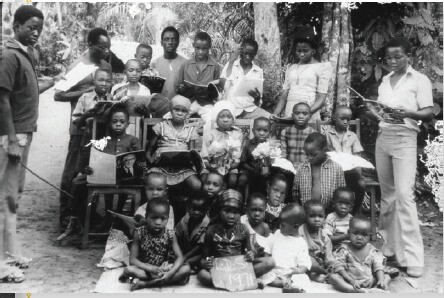
Anthony Obinna with group, Nigeria
When the missionaries arrived in Nigeria in 1978, they found many prepared for the gospel through the teaching and leadership of Anthony Obinna. Obinna was the first to be baptized. His wife was the first Relief Society president called in black Africa. Some years later, with help from former missionaries who knew and loved them, Brother and Sister Obinna were sealed in the temple.
The Revelation
There were many touching moments the people of Africa experienced when they received word of the 1978 revelation. One such moment was one I shared with Moses Mahlangu, a valiant pioneer from South Africa.
Mahlangu first found an old, beat-up copy of the Book of Mormon in 1964, read it, and knew it was true. But since the title page had been torn out, he didn’t know the source of the book. For two years, Moses preached from the Book of Mormon and shared it with pastors of other faiths before finally discovering that this new book of scripture was published by The Church of Jesus Christ of Latter-day Saints. He made contact with Church authorities and met with all of the mission presidents beginning in 1966.
Soon after I arrived in South Africa as the new mission president in 1976, Mahlangu came to meet me at the mission office in Johannesburg. His conviction, knowledge, and dedicated efforts to share the gospel message with others deeply impressed me. He regularly came to the mission office to get a new supply of pamphlets, tracts, and copies of the Book of Mormon. Fluent in nine languages, he was an articulate and inspiring teacher, yet a humble man of simple faith.
As soon as news of the revelation reached the mission in June 1978, I thought of Mahlangu, but I didn’t know how to contact him. He lived in Soweto, a township near Johannesburg, and did not have a telephone. But within a few days, he surprised me with a phone call from a nearby chapel. The custodian there had told him about the revelation and he wanted to know if it was true. “Yes,
Moses,” I said, “it is true! Wait right there. I want to visit with you.”
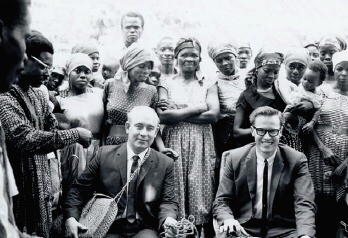
Wright and Williams among Saints in Nigeria, 1965
I rushed to meet him, and as I ran up the steps to the meetinghouse, Mahlangu ran to meet me. We embraced and wept. “Does this mean that I can now have the priesthood?” he said. “Would you like to receive the priesthood, Moses?” I asked. He beamed from ear to ear and with tears in his eyes said softly, “I have waited for 14 years.”
Speaking of the revelation, President Spencer W. Kimball noted, “Now has come one of the greatest changes and blessings that has ever been known.” Elder Bruce R. McConkie, who was present when the revelation was received, said, “It was a revelation of such tremendous significance and import; one which would affect the living and the dead; one which would affect the total relationship that we have with the world.”
Continued Growth
During the first few years following the revelation of June 1978, thousands of valiant Africans were baptized, received the priesthood, participated in the saving ordinances of the temple, and formed a strong foundation for explosive growth of the Church in Africa. One of these early pioneers is Emmanuel Kissi.
As a child growing up in Ghana, Kissi had two burning desires: he wanted to practice medicine and he wanted to find the true religion. By the time he finished medical school, Dr. Kissi had read the Bible three times and concluded that the church he was seeking did not exist in Ghana. In 1977, he took his family to England to continue his medical studies. Dr. Kissi was confident that if the true religion existed, it could be found in England, which he felt was the center of civilization.
One day while he was at work, two missionaries came to his home. They introduced themselves as servants of God. Dr. Kissi’s wife, who had been very ill for many weeks, asked them to bless her. When they did, she was healed immediately. Dr. Kissi was greatly surprised when his wife phoned to say that servants of God had healed her and were now prepared to teach them about the true religion. After he read the Book of Mormon, Gospel Principles, A Marvelous Work and a Wonder, and Jesus the Christ, Dr. Kissi was ready for baptism.
Regarding Joseph Smith’s search for the true church, Dr. Kissi observed, “I realized that Joseph Smith had the same problem that I had. His story was so close and similar to my situation. I put myself in his place, and I found myself enjoying every bit of his experience.”
The Church has seen spectacular growth in Africa because of the faith of the people and their dedication to spreading the gospel message. One example of this kind of conviction and missionary zeal is Reuben Okuchukwu Onuoha of the Aba Nigeria Stake.
All his life, Onuoha had felt spiritual yearnings and restlessness. He readily accepted the gospel when he was introduced to it. However, he and his large family lived about 20 miles from the nearest branch, and it was not possible for them to travel that distance to attend church meetings each week. So the same week he was baptized, Onuoha shared the gospel with three other families,
who joined the Church. A branch was then organized in the Onuoha home, with Reuben called as the branch president. Four months later, there was no longer space in his home for the 80 people he had brought into the Church, so they rented a larger facility.
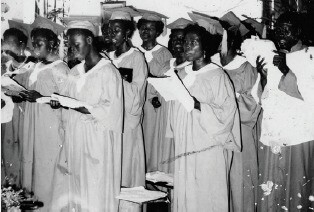
Cape Coast Choir
Another humble pioneer of the Church in Ghana is Lily Andoh-Kesson. Andoh-Kesson grew up in poverty and received only part of one year of formal schooling. As was common to her culture, she did not meet her husband until the day they married. She bore 16 children and raised 13 to maturity. She could not speak or understand English. She could not read the Book of Mormon or any other Church literature since none had been translated into her native language, Fante.
Andoh-Kesson prayerfully considered the teachings as they were explained to her, and she felt deeply that they were true. She was one of the first to be baptized when the missionaries arrived in 1978. Because the missionary couples from America did not speak Fante, Church meetings were held in English, and some of the early converts who could not understand English returned to their former churches, where their native languages were spoken. When asked why she did not leave also, Andoh-Kesson responded, “I stayed because I had the feeling that in everything we have to exercise faith in God.” The influence of her great example and love for her family has brought 12 of her married children and their families into the Church.
Priscilla Sampson-Davis, also of Cape Coast, Ghana, joined the Church in 1979. Through her faith and encouragement, her oldest son gave up a lifelong dream and a four-year scholarship to an Anglican theological school and was baptized. Twenty months later, he was one of the first full-time missionaries from West Africa.
One Sunday after sacrament meeting, Sampson-Davis had a vision in which she was shown some members of the congregation unable to join in singing the hymns. She felt she was being asked to help them by translating the English hymns into Fante. “Though I wasn’t very good in the language, I could speak,” she said. “It is my mother tongue, but I couldn’t write well. I didn’t say no. I said, ‘I will try. I will do my best.’ So I immediately got up. I took paper and pencil and started translating 'Redeemer of Israel’ right away into Fante.”
The hymns were eagerly received by the Ghanaian Saints. After translating the hymn book, Sister Sampson-Davis translated missionary pamphlets and filmstrips, Gospel Principles, Stories of the Book of Mormon, and the Book of Mormon. By 1988, she was translating the Doctrine and Covenants and the Pearl of Great Price.
The growth of the Church in Africa is unprecedented. Forty years after the 1978 revelation, there are more than 400,000 Latter-day Saints in Africa. As of 2018, there are three operating temples on the continent with two more under construction and another two in the planning stages. The marvelous revelation allowing all worthy male members of the Church to receive the priesthood opened the floodgates for those who had waited patiently for so many years.
All images courtesy of E. Dale LeBaron
E. Dale LeBaron was an instructor and administrator of seminary and institute programs as well as a professor of Church history at Brigham Young University. While serving as a professor of Church history, he traveled to 10 African countries and collected more than 400 oral histories, took hundreds of photographs, and gathered other information to establish a foundation for a history of black Latter-day Saints in Africa, from which was published a book titled All Are Alike unto God. He passed away in December 2009.
